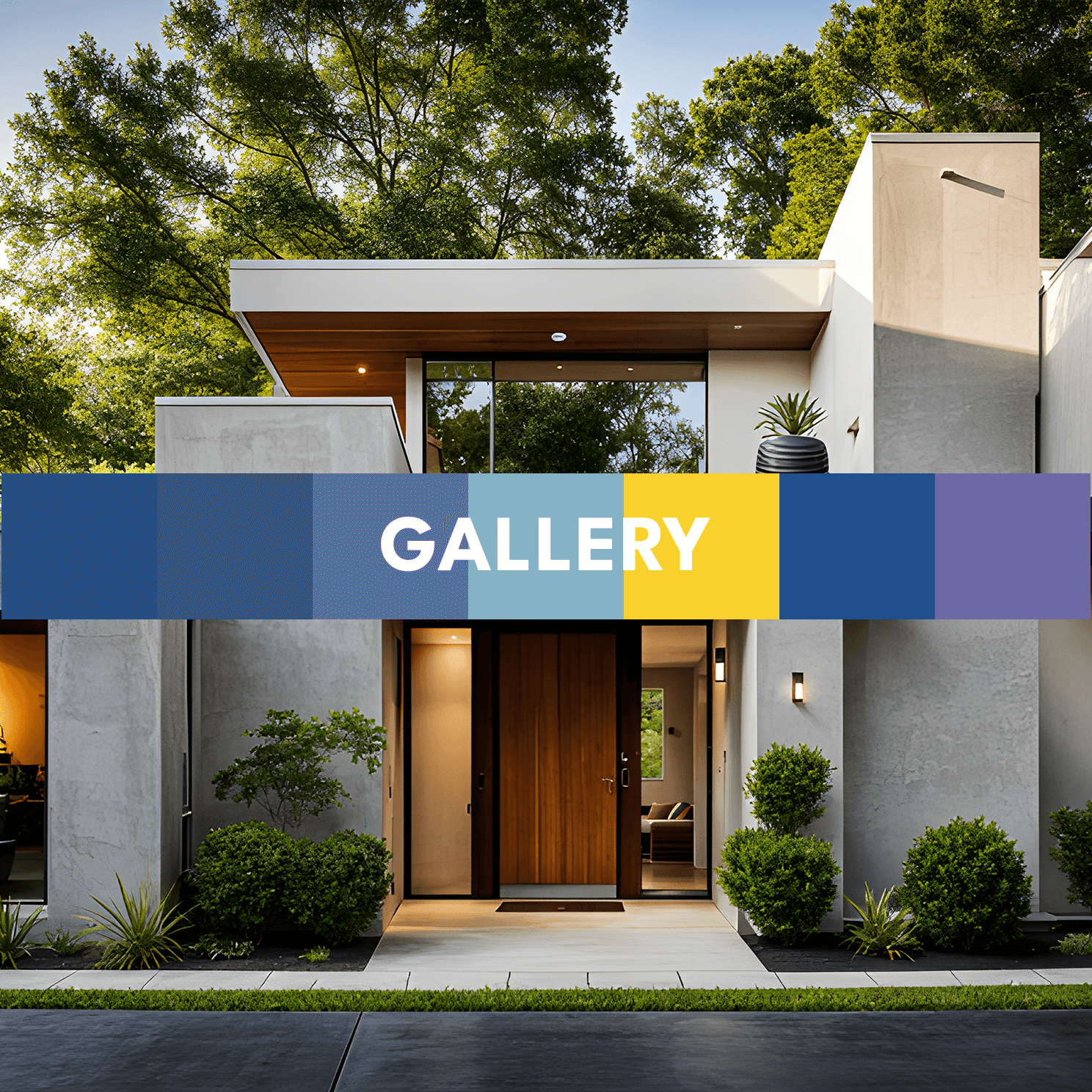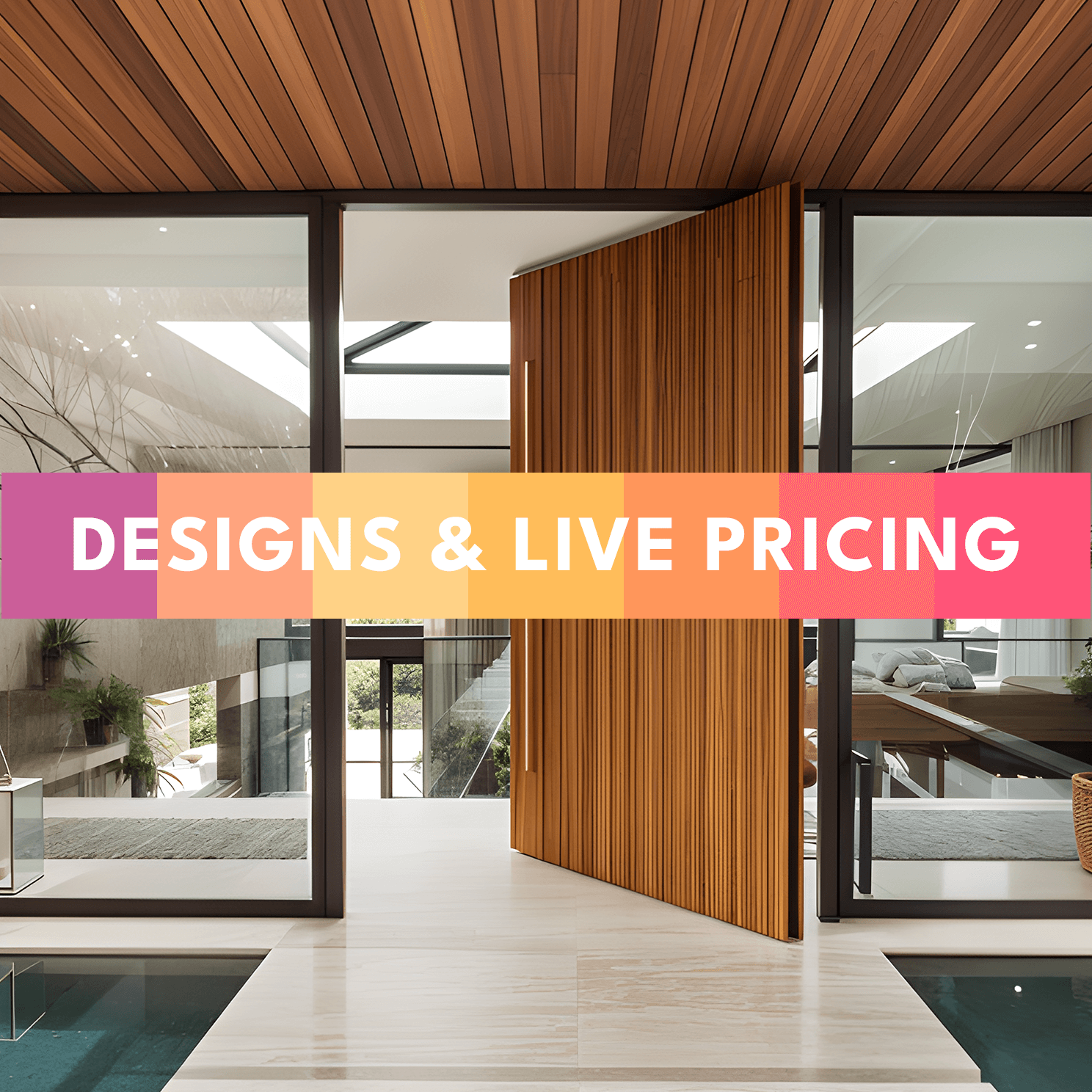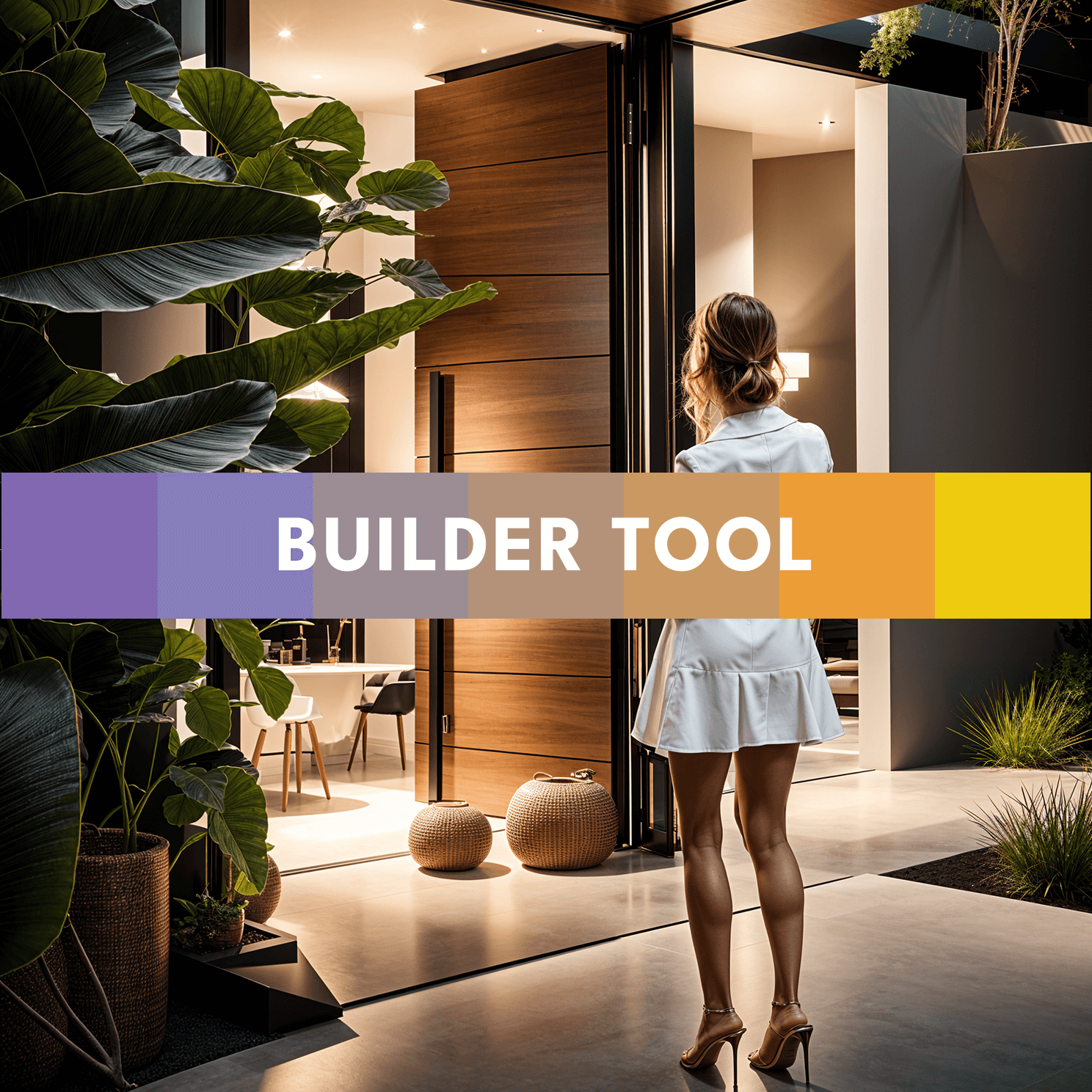10% OFF all customizable doors thru 3/31
No products in the cart.
Footer
P
I
V
O
T
At Pivot Door Company, we are renowned for crafting luxury exterior pivot doors that make a statement in both residential and commercial settings. Our collection features modern, contemporary, and oversized pivot doors made from premium wood with a steel core—blending exceptional craftsmanship with innovative design. As a top choice for discerning builders and designers, our custom entry pivot doors offer unparalleled elegance and functionality. Use our builder tool to visualize how our designer doors will enhance your property, or reach out to our team to design a custom, bespoke door tailored to your exact specifications. Discover why our standard, large, even huge, pivot doors are the ultimate solution for stunning homes and prestigious projects.
Window Placement
If you choose a door style with a window, you have the option to place the window on the handle side or on the pivot side.
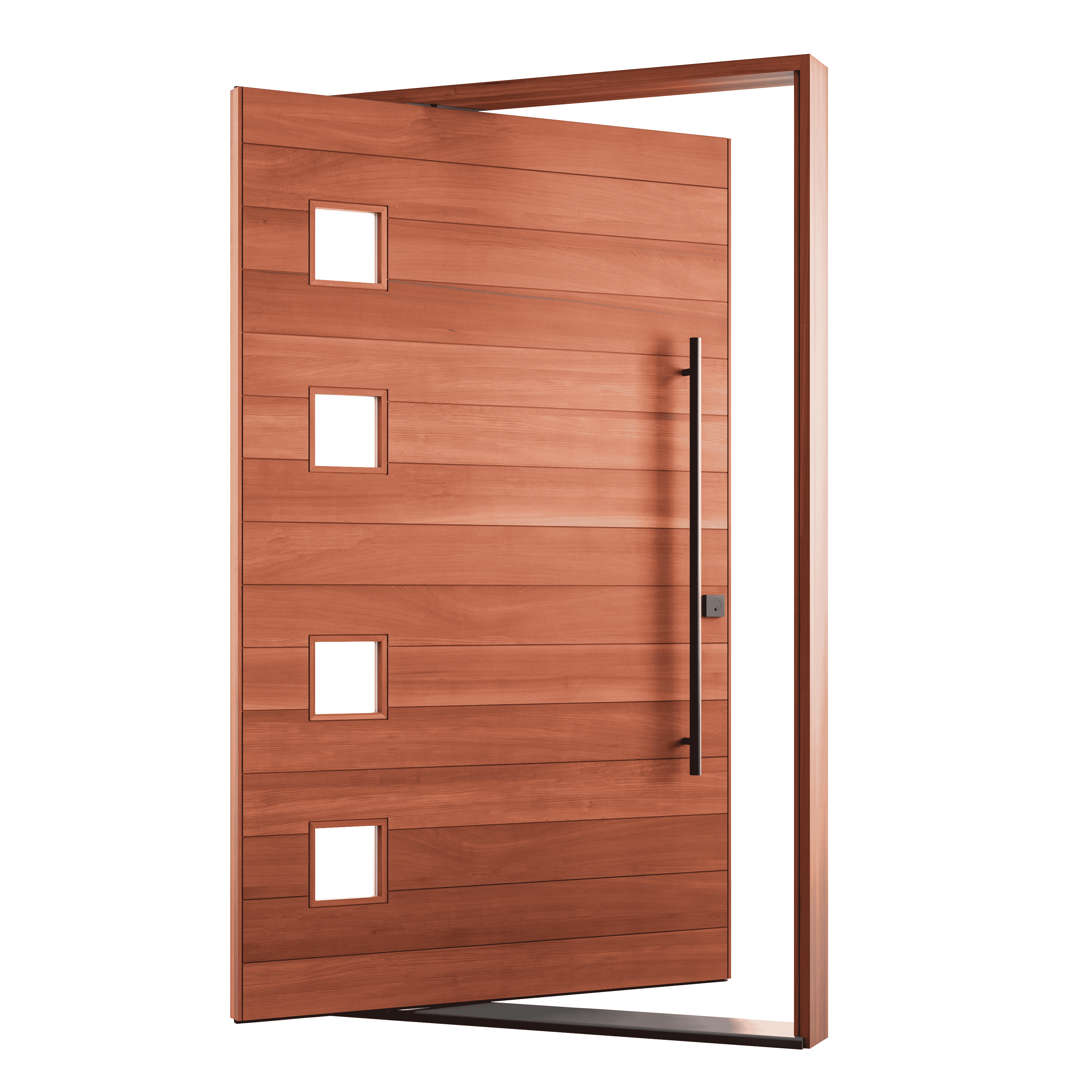
WINDOW ON HANDLE SIDE
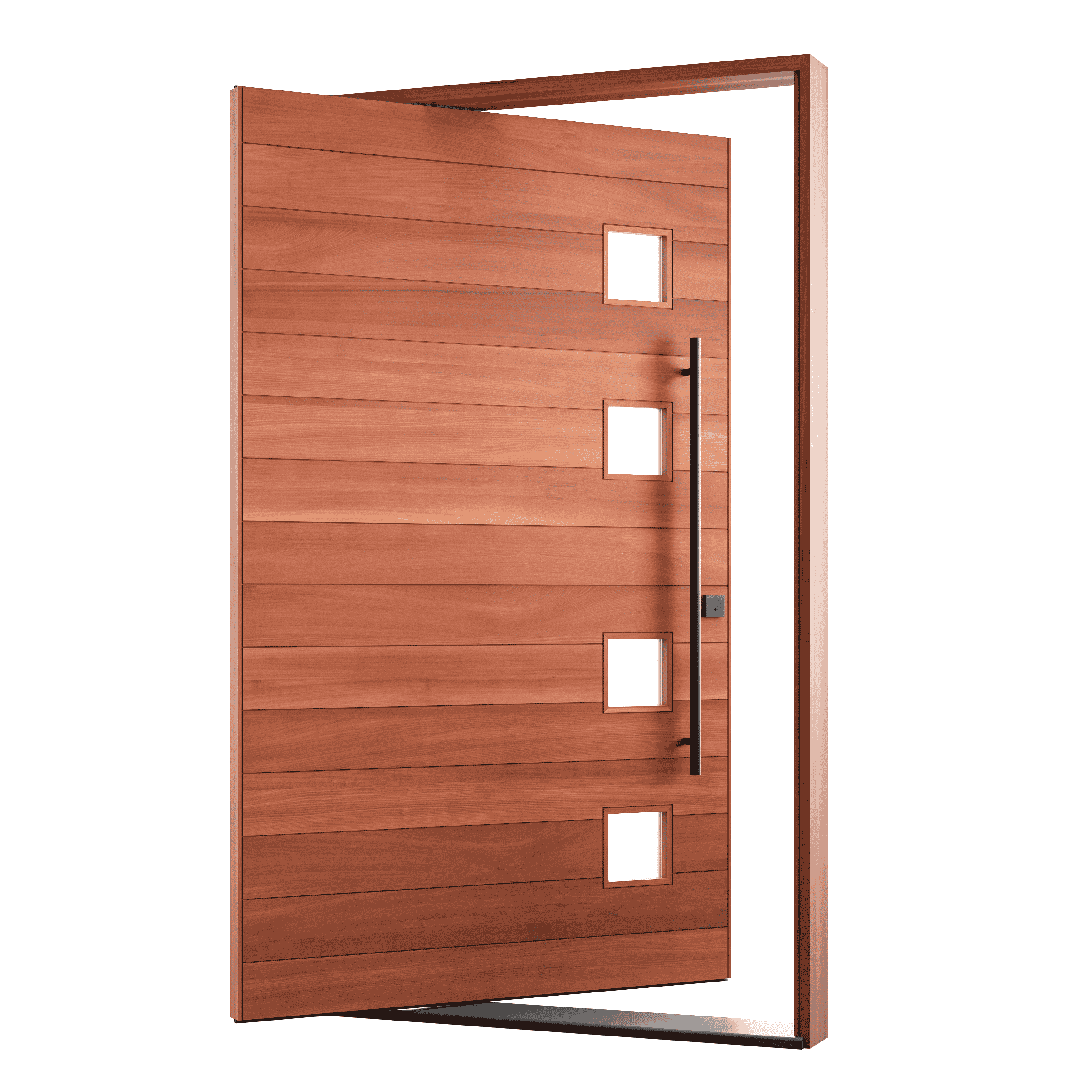
WINDOW ON PIVOT SIDE
Double Swing Configuration
When you order your pivot-hung entryway, you have options when it comes to how the door will swing. Though 99% of the time, you will want a door that swings into the interior (in-swing), we are set up to build jambs where the door swings out to the exterior (pushing your visitors out of the pathway of your tremendous door).
However, when it comes to right-hand or left-hand swing, the layout of your installation site will determine the swing configuration. To determine if the door is left-hand or right-hand in-swing, imagine you are looking at the door from the street. If the pivot point is on the left side, it is a left-hand in-swing. If the pivot point is on the right-hand side, the door is a right-hand in-swing.
Diagram of Potential Configurations – Swing configuration defines the direction of the door motion and from which side the pivot is placed.
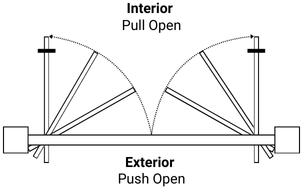
Double Swing In
Opens to Interior
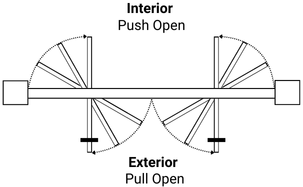
Center Swing Out
Opens to Exterior
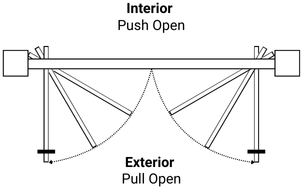
Double Swing Out
Opens to Exterior
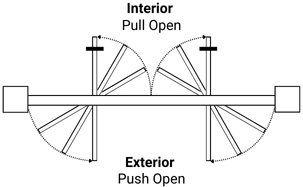
Center Swing In
Opens to Interior
Pivot Hardware
Free Swing Pivot Hinge
Our standard pivot hardware is a durable, specially engineered free-swing pivot hinge. This pivot hardware works for a wide range of doors, from small to very large. No matter the door size, the free-swing pivot hinge allows for effortless door operation. The hardware incorporates sets of ball-bearings for smooth, long-lasting performance. The door swings freely around the pivot point. There are no springs or tension pulling the door closed.
Closer< Dorma BTS/80
In commercial applications and in rare residential applications, we install a bottom closer. The bottom closer creates constant tension on the door’s swing to pull the door into the closed position. This means one must hold the door in order to keep it open. With a closer the door will not rest in an open position unless the hold-open feature is activated, which holds the door open at a 100° angle.
SideLights
GLASS SIDELIGHT PLACEMENT ON DOOR UNIT
You can choose between the following sidelight configurations: – Right Sidelight – Left Sidelight – Transom light – Double Sidelight – Left Sidelight with Transom – Right Sidelight with Transom – Double Sidelight with Transom.
Sidelight placement is specified with reference to the exterior view. If you want a 12″ sidelight that is on the right side when viewed from the exterior, click on the dropdown options under “Right Sidelight” and select the option: 12″ right sidelight. If you want a double sidelight, simply a size under both the the Right Sidelight and Left Sidelight options. Double sidelights can be of different sizes.
NET SIDELIGHT SIZE
This is the size of the actual Sidelight jamb. When inputting the net frame size you want to put in a number that is at least a half inch less than the rough opening size to allow room to square and level the unit. The door will be built with the sidelight attached so be sure to input the height of the door and the height of the sidelight the same.
Example: 48″ X 98″ door with a 18″ X 98″ sidelight will get you a door and sidelight combo that measures 66″ X 98″ (the rough opening size should be somewhere around 66 1/2″ X 98 1/2″).
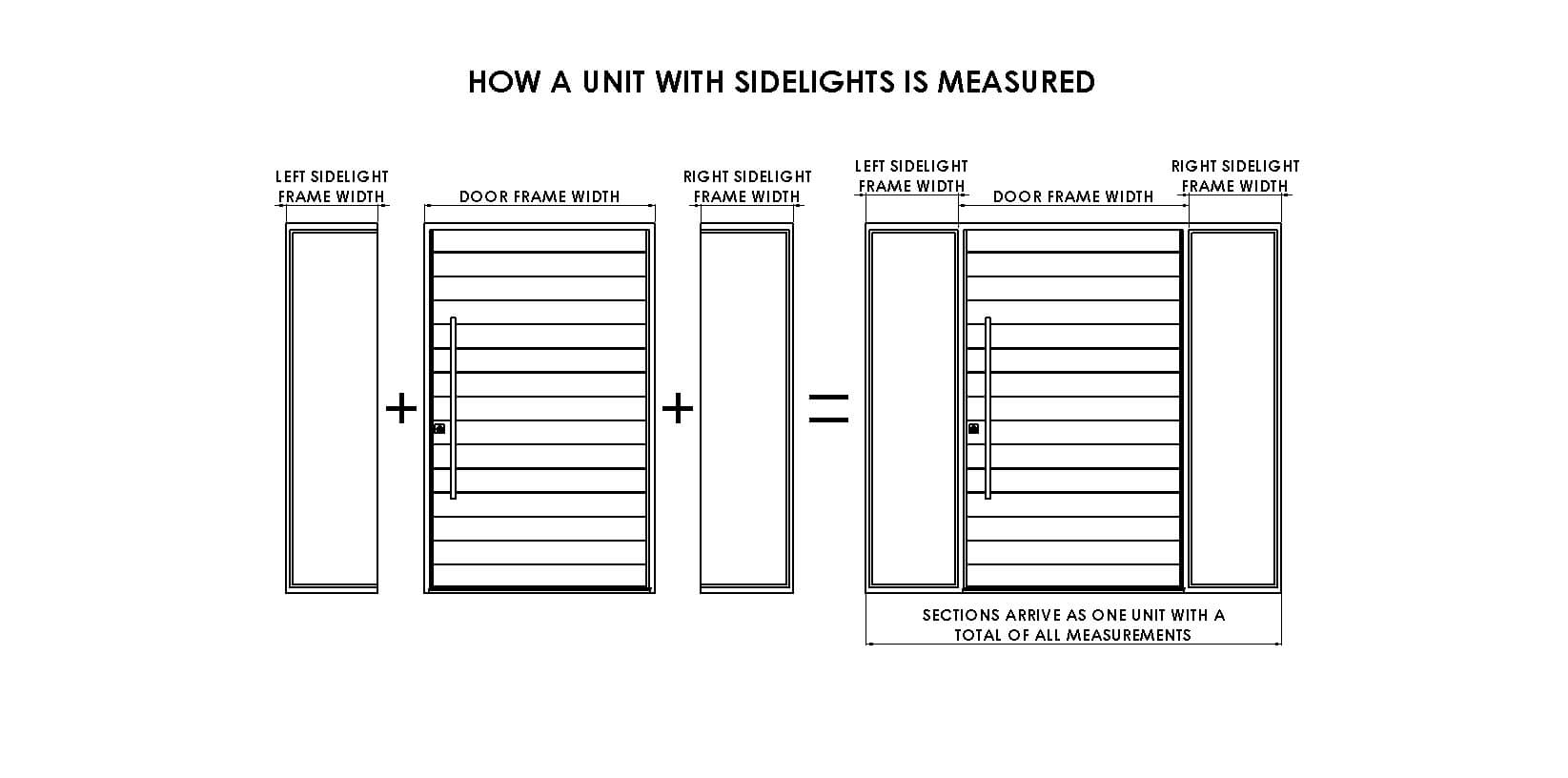
Door Action
The Door Action describes how a door swings. A single acting door swings just one direction, in or out. A double acting door swings two directions, in and out.
Pivot Placement Exterior Wall System
The pivot placement is the distance the pivot pin will be placed away from the vertical edge of the rough opening. Generally speaking, we suggest placing the pivot over one quarter of the distance of the door width. We find that this presents a solid aesthetic for most door dimensions.
The pivot placement indicates where your want the doors in the wall system to pivot. The pivot distance can be 1/4 the width of the door, which means the pivot will be placed a quarter of the way into the door. If you choose a pivot distance of 1/2 the width of the door, the pivot will be placed in the center of the door on each door in the wall system. You may also choose a fixed pivot distance of 4 inches, regardless of the door width. Please contact us if you need a custom pivot placement. See the diagram below for a visual representation.

Custom Wood Handle
The Custom Wood Handle for the Kogan door is 3″ wide, 1 1/4″ deep. The length will be determined by your door size in order to fit within the top and bottom rail correctly. the Custom Wood Handle will come unfinished, stain ready (same as the door). Handle is sold as a set (one for interior and one for exterior). You have an option to choose a different wood type for the handle than for the door. Mahogany – Sapele is shown in the product photo above.
When purchased alongside the Kogan, Pivot Door Company will custom make your handle to fit your door size, prep your door appropriately. The handle will still need to be installed on site after the door is installed. This ensures we’re able to appropriately package the handle so it is not damaged during shipping and the door can lay flat for shipping.
Pivot Hardware
Free Swing Pivot Hinge
Our standard pivot hardware is a durable, specially engineered free-swing pivot hinge. This pivot hardware works for a wide range of doors, from small to very large. No matter the door size, the free-swing pivot hinge allows for effortless door operation. The hardware incorporates sets of ball-bearings for smooth, long-lasting performance. The door swings freely around the pivot point. There are no springs or tension pulling the door closed.
Closer< Dorma BTS/80
In commercial applications and in rare residential applications, we install a bottom closer. The bottom closer creates constant tension on the door’s swing to pull the door into the closed position. This means one must hold the door in order to keep it open. With a closer the door will not rest in an open position unless the hold-open feature is activated, which holds the door open at a 100° angle.
Freight Curbside Delivery
Our standard shipping method is Freight Curbside Delivery. This means a driver will arrive at the delivery site, and will not assist in getting the door off of the truck or moving it up the driveway. You will need to have 4-5 able-bodied laborers available to unload the crate off of the truck, to help balance the crate as the driver lowers the lift-gate. Your laborers can then move the crate up the driveway, to the garage or front for installation. You may also have a forklift with extensions to unload or a receiving dock if you’re unable to have laborers available to receive the delivery.
Most customers receive their crate in about 4 business days. The Shipping Company takes 3-5 business days to receive your crate in your local dock. Then they will call the shipping contact to arrange a delivery window based on their specific truck/driver availability. They can hold it for a maximum of 72 hours before they will label it as rejected and ship it back to us.
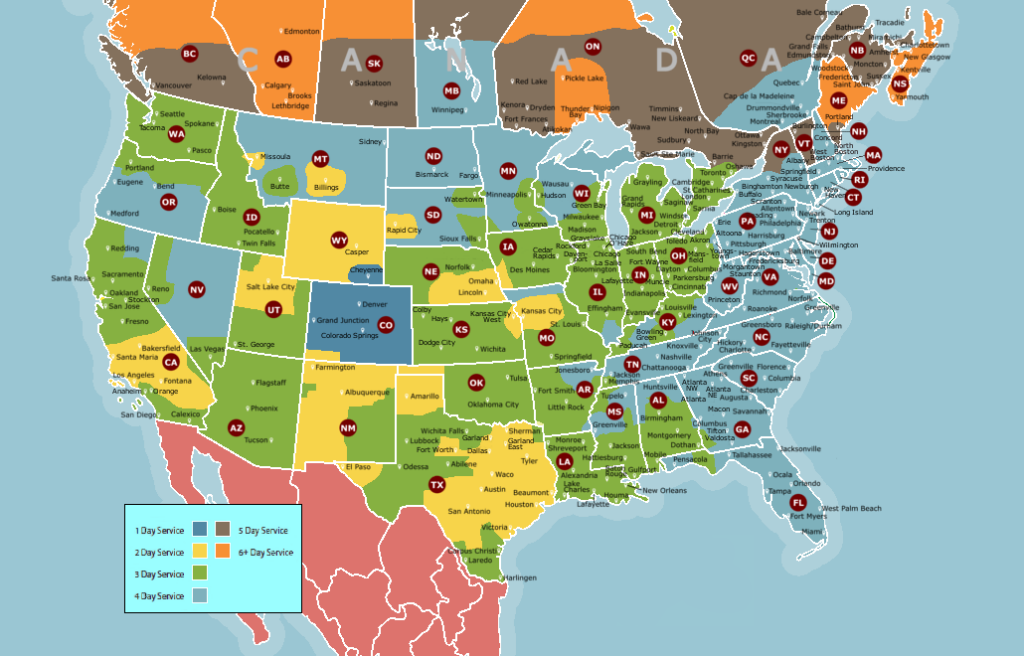
Inside Delivery – $3000
If you are not able to receive a curbside delivery. We do offer an inside delivery option. Please contact our sales department to discuss this option. (719) 425-4289
Pivot Door Company will hire a local third party moving company to move your crate from your local dock or accept delivery at your job site. The shipping contact will still need to be available to coordinate the delivery onsite. The moving company will then transport your crate inside your garage or house. Please note, the customer will be responsible for the conditions of the area it is stored. Our crates are not weatherproof. The shipping crate cannot be stored or transported on its side, only flat. While the moving company may take off the top crate lid for you to inspect the contents, they are not responsible for fully uncrating or removal of any trash.
International FedEx Freight Curbside
Canada shipping includes standard international curbside shipping as stated in the above “Freight Curbside Delivery”. All taxes, duties and custom fees are included in the flat rate price. You will not receive another bill for importing/shipping.
Net Frame Size
CHOOSING A DOOR SIZE
Because each door we make is sized specifically for the project, you are not restricted to any standard sizes.
Measurements To Know
When sizing the door you will need to consider two principle measurements, rough opening and frame size. See the image below for reference.
Inside
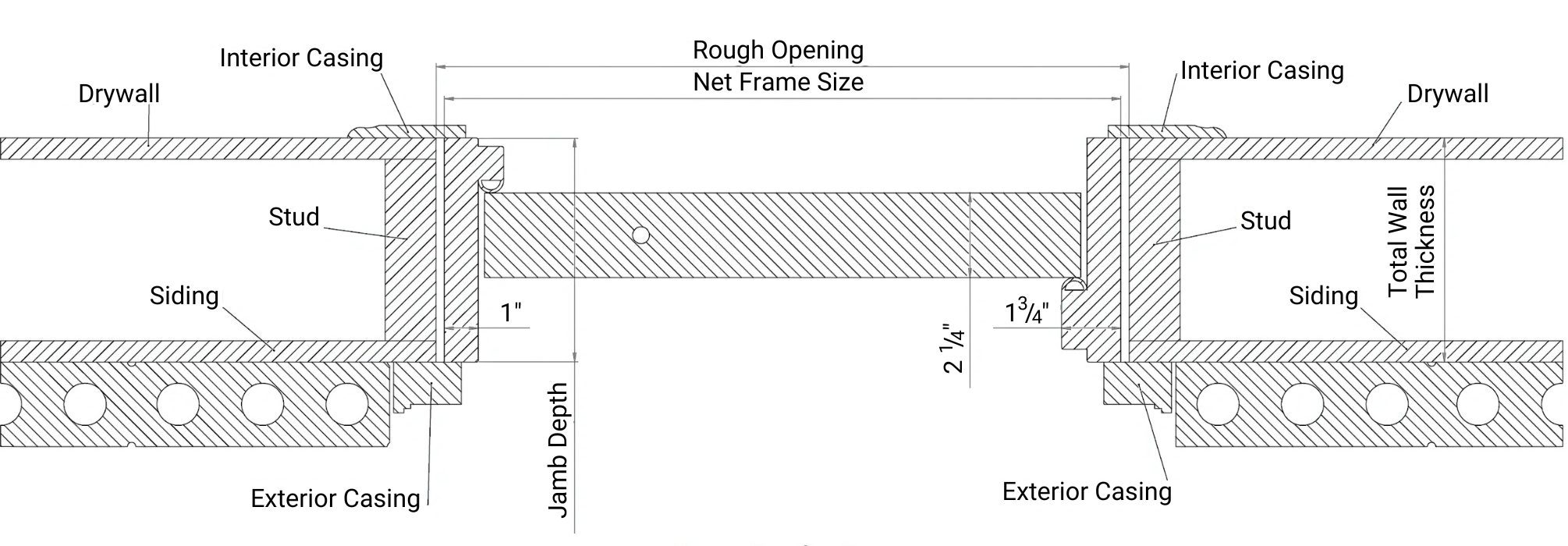
Outside
Rough Opening
The rough opening is the distance from stud to stud for framing purposes. We advise that you build a rough opening that is ½ in. wider and 1/2 in. taller than the total door unit. We find that this allows for sufficient shimming and adjustments during installation.
NET FRAME SIZE: WIDTH AND HEIGHT
This is the size of the actual door jamb. When determining the net frame size you want to put in a number that is at least a half inch less than the rough opening size to allow room to square and level the door. For example, for a rough opening 48 in., order a net frame size of 47 1/2 in.
Jamb Depth
Jamb depth depends on the thickness of the walls into which the door unit will be placed. Most walls are studded out with 2×4’s or 2×6’s, and so, our most common jamb depths are 4 5/8 in. and 6 5/8 in., respectively. Usually the jamb is flush with the interior and exterior wall covering, with the seam covered by casing.
We have standard jamb depths of:
4 5/8 in.
5 1/4 in.
5 1/2 in.
6 5/8 in.
7 1/2in.
If you wish for us to provide a jamb depth different from one of our standard options, please contact us.
Inside

Outside
Vertical Plank Placement
If you choose a door style with a steel plank, you have the option to place it on the handle side or on the pivot side.
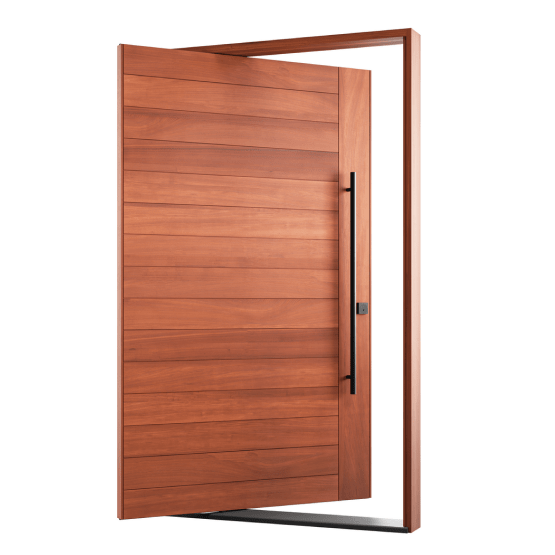
VERTICAL PLANK ON HANDLE SIDE
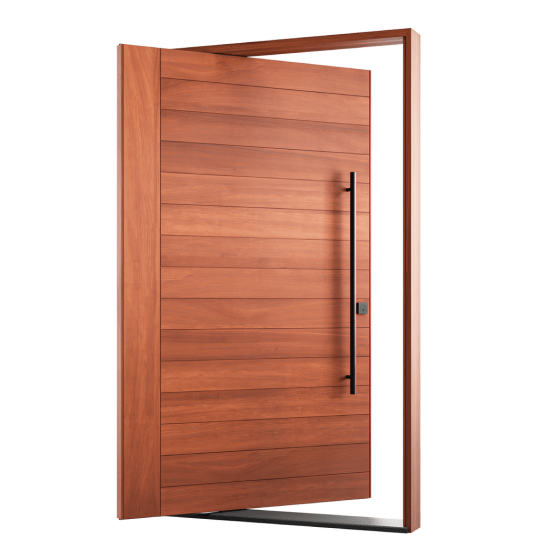
VERTICAL PLANK ON PIVOT SIDE
Swing Configuration
When you order your pivot-hung entryway, you have options when it comes to how the door will swing. Though 99% of the time, you will want a door that swings into the interior (in-swing), we are set up to build jambs where the door swings out to the exterior (pushing your visitors out of the pathway of your tremendous door). However, when it comes to right-hand or left-hand swing, the layout of your installation site will determine the swing configuration. To determine if the door is left-hand or right-hand in-swing, imagine you are looking at the door from the street. If the pivot point is on the left side, it is a left-hand in-swing. If the pivot point is on the right-hand side, the door is a right-hand in-swing. Swing configuration defines the direction of the door motion and from which side the pivot is placed.
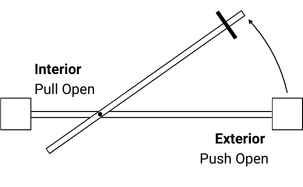
Left Hand In Swing
Opens to Interior
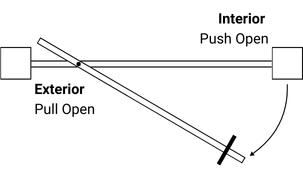
Left Hand Out Swing
Opens to Exterior
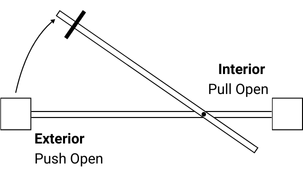
Right Hand In Swing
Opens to Interior
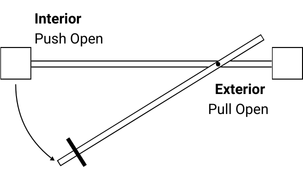
Right Hand Out Swing
Opens to Exterior
Pivot Placement
The pivot placement is the distance the pivot pin will be placed away from the vertical edge of the rough opening. Generally speaking, we suggest placing the pivot over one quarter of the distance of the door width. We find that this presents a solid aesthetic for most door dimensions. If your rough opening is 48” and you choose a 9” pivot placement, the door will roughly have a 37” pass through opening. You want to ensure you leave at least a 36” opening. (Rough opening width – pivot placement measurement – 4 in. for jamb = a number greater than 36). See picture for details or contact us for clarification.
Pivot Placement
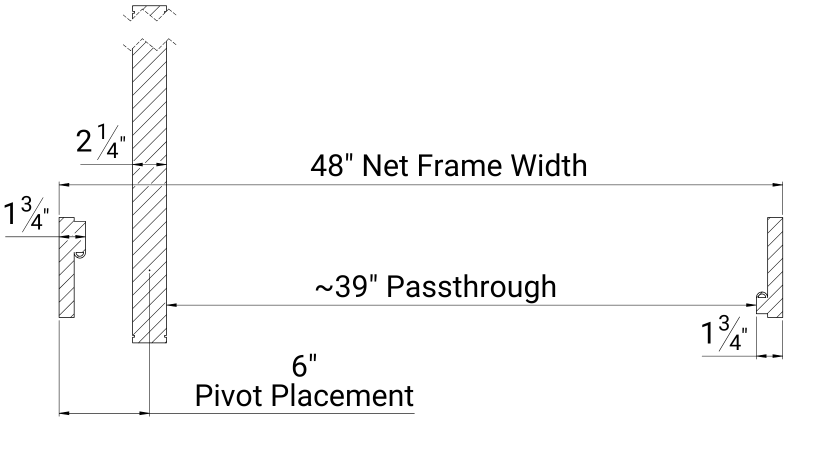
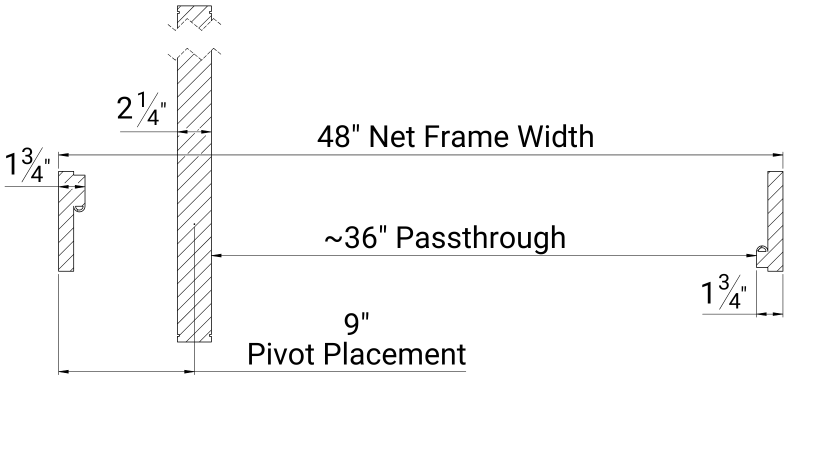
Suggested Pivot Placement
|
Door Slab Width
|
Pivot Placement
|
| 42″ – 44″ | 4″ |
| 45″ – 47″ | 6″ |
| 48″ – 53″ | 9″ |
| 54″ – 60″ | 12″ |
| 61″ – 66″ | 15″ |
| 67″ – 70″ | 18″ |
| 71″ – 74″ | 21″ |
| 75″ – 80″ | 24″ |
| 81″ – 84″ | 30″ |
Window Placement
If you choose a door style with a window, you have the option to place the window on the handle side or on the pivot side.
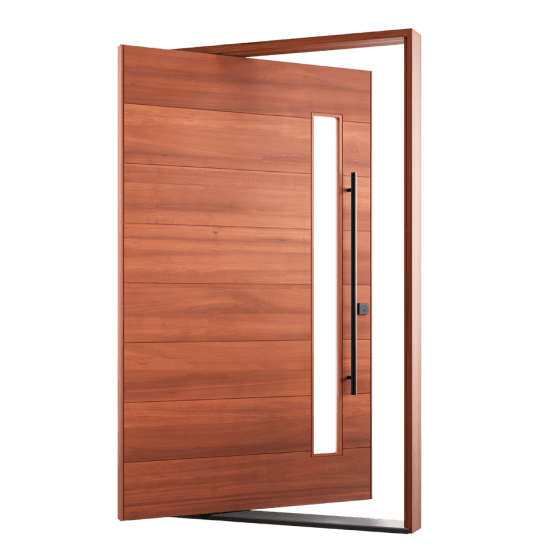
WINDOW ON HANDLE SIDE
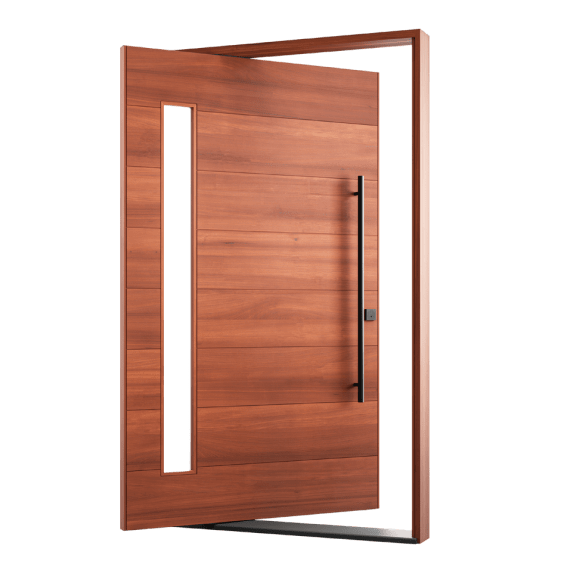
WINDOW ON PIVOT SIDE
Threshold
Color & Type
Color & Type
Threshold Color
You may choose between two different finishes for the aluminum threshold cover plate; Black or Grey.
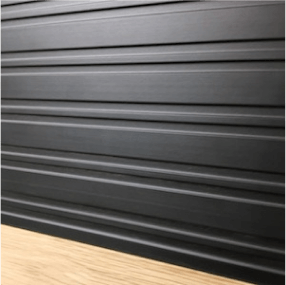
Black Threshold
Dark Bronze Anodized
Dark Bronze Anodized
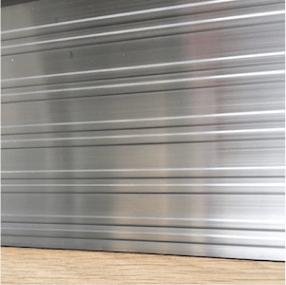
Grey Threshold
Mill Finished Aluminum
Mill Finished Aluminum
Threshold Type
You may choose between two different finishes for the aluminum threshold cover plate; Black or Grey.
If there is any type of wood covering on the interior of the house, you will need a type 2. The type 2 threshold has a 90 degree angle on the interior facing side for the wood covering to butt up against. If the exterior floor is the same level as the interior floor, you will need a type 1 threshold. More commonly, though, the exterior floor is lower than the interior floor and you will need a type 2 threshold.
Threshold Options
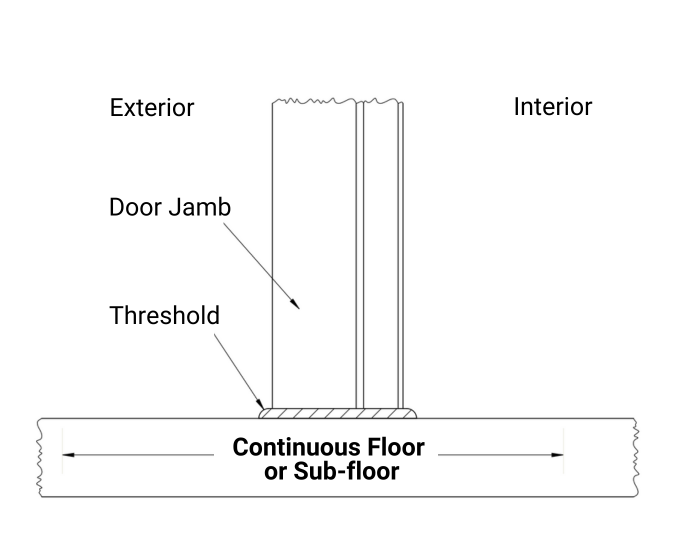
Threshold Type 1
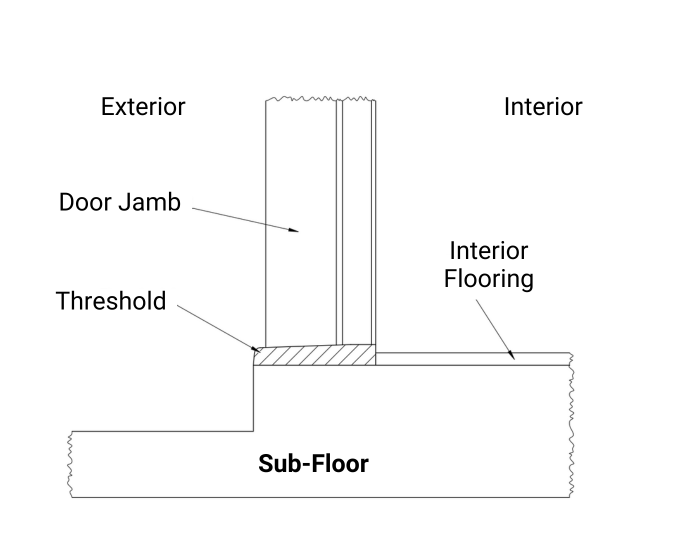
Threshold Type 2
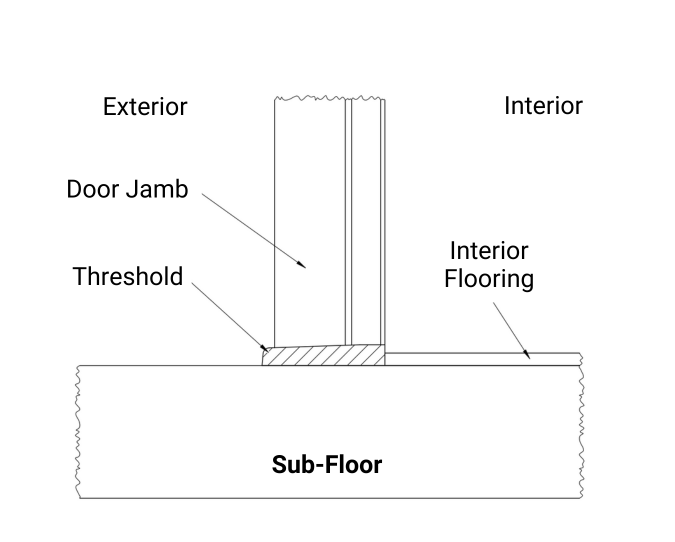
Threshold Type 2
Threshold
Color & Type
Color & Type
Threshold Color
You may choose between two different finishes for the aluminum threshold cover plate; Black or Grey.

Black Threshold
Dark Bronze Anodized
Dark Bronze Anodized

Grey Threshold
Mill Finished Aluminum
Mill Finished Aluminum
Threshold Type
You may choose between two different finishes for the aluminum threshold cover plate; Black or Grey.
If there is any type of wood covering on the interior of the house, you will need a type 2. The type 2 threshold has a 90 degree angle on the interior facing side for the wood covering to butt up against. If the exterior floor is the same level as the interior floor, you will need a type 1 threshold. More commonly, though, the exterior floor is lower than the interior floor and you will need a type 2 threshold.
Threshold Options

Threshold Type 1

Threshold Type 2

Threshold Type 2
Deadbolt &
Handleset Prep
Handleset Prep
Single Bore
Single Bore is for the iconic pull bar and deadbolt set up. We will pre-drill the door for a handle with 2 3/8 in. or 2 3/4 in. backset. Standard bore diameter is 2 1/8 in. The term “backset” refers to the distance from the edge of the door to the center of the bore hole and is a personal preference. We suggest the smaller of the two options, 2 3/8″ especially if the dorr has glass. See the diagram below for more details.
Double Bore
Double Bore is for a traditional entry-set. We will pre-drill the door for a handle with 2 3/8 in. or 2 3/4 in. backset. Standard bore diameter is 2 1/8 in. The term “backset” refers to the distance from the edge of the door to the center of the bore hole and is a personal preference. We suggest the smaller of the two options, 2 3/8″ especially if the dorr has glass. See the diagram below for more details.
Mortise
We can mortise the door for many entry lock sets. Please contact us directly to configure your specific requirements.
Other
If you wish for us to prep for a handle you purchase from another vendor, you will need to provide us with the specifications for the handle or lockset so we can properly prep. You may be required to send it to us for us to adequately prep your door.
- Alternatively, you may decide that you want to wait and have a local carpenter prep the for the door handle.
Standard Handle Prep
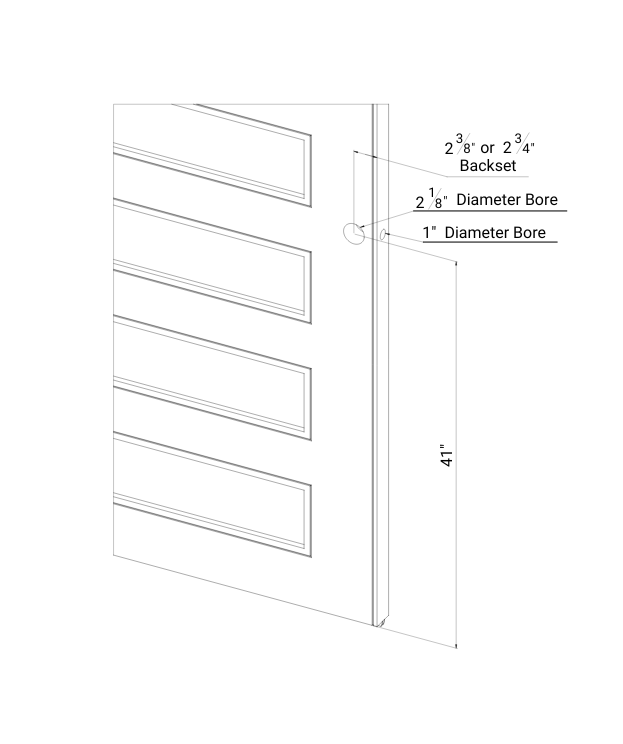
Single Bore
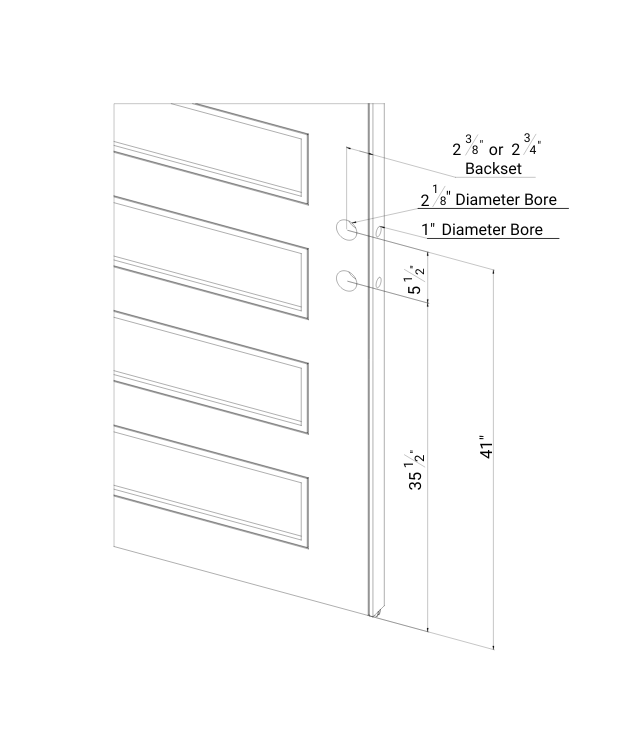
Double Bore
Glass Color
Standard Glass Options
All glass we install is 1″ thick tempered double-paned, insulated glass. Clear and frosted glass patterns are standard pricing options.
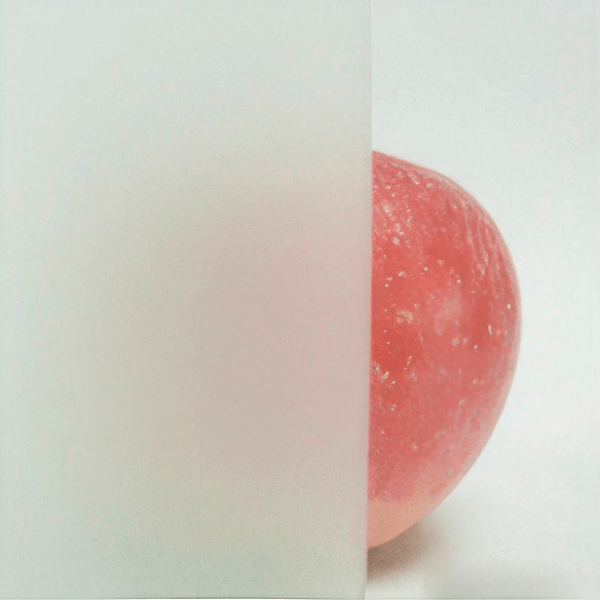
Frosted White Glass
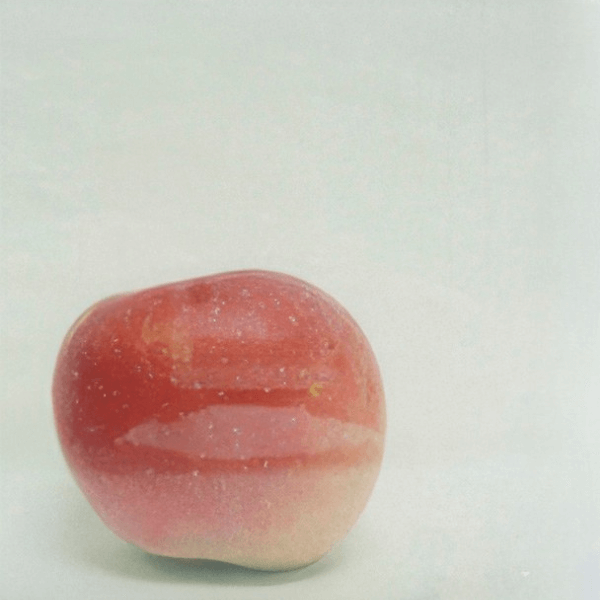
Clear Glass
Customization Glass Options
If you are looking for different finish or insulating options, contact us directly and we can provide pricing.You can vary the glass pattern (rain, reflective, glue chip, reeded etc.), glass construction (low e, laminated) or tint (grey, brown tints).
Rain
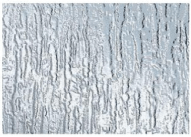
Pattern 62
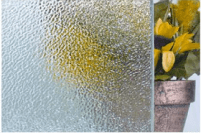
Reed
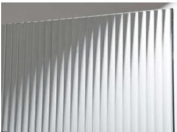
Glue Chip
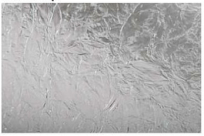
Velve X

Custom Glass Tint
Greylite II
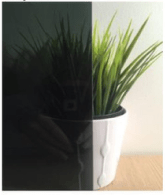
Bronze
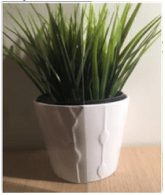
Rush Option
Standard 6 Weeks Lead Times
Your door leaves the shop six weeks from order confirmation. Allow additional time* for freight delivery. See map below for approximate transit times to your region.
*Pivot Door Company guarantees ship dates; we do not guarantee delivery times. Ship times depend on the carrier. That being said, we have come to trust and see great reliability in Fedex Freight.
Rush Shipping
If six weeks is not soon enough, we can manufacture a custom door sooner if you choose the Rush Option. The additional charge covers reducing production time by 2 weeks including but not limited to; paying the extra hours worked by the production team, paying rush charges for any specialty hardware/materials not in stock. While most door designs are able to be completed in this time frame, some designs may require additional time in production. This rush time frame will be shown on your order before you sign for final order confirmation to begin production. Allow additional time* for freight delivery. In order to cut down on shipping time, your order may be sent FedEx Freight Priority instead of Economy. See map below for approximate transit times to your region.
Wood Type
CHOOSING A WOOD SPECIES
We offer a range of wood species to go standard with our doors. If you would like something other than what we have, in most cases we can source other wood types that are not listed below, though prices will vary.
As you decide which wood you’ll choose please consider these important factors. How the wood species will react to your climate and site condition. Also, how it collaborates with the overall design of the door and your project. If you have specific questions about what wood to choose that are not answered here, feel free to reach out to us.
As you decide which wood you’ll choose please consider these important factors. How the wood species will react to your climate and site condition. Also, how it collaborates with the overall design of the door and your project. If you have specific questions about what wood to choose that are not answered here, feel free to reach out to us.
Our Standard Selection
Images are for reference only. All orders are shipped out unfinished and stain ready. (No stain or clear coat)
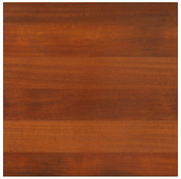
Mahogany/Sapele
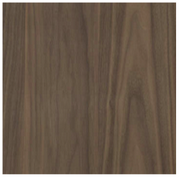
Walnut
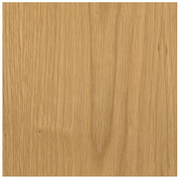
White Oak
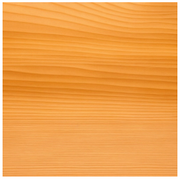
Cedar
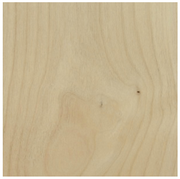
Premium Alder
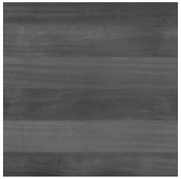
Paint Grade
Mahogany (Sapele)
African Mahogany (Sapele) is a reddish-brown hardwood wood and is desired for its rarity, strength, and beauty. It is one of our most durable, and resists swelling and warping, making it ideal for harsher environments and coastal climates.
White Oak
White Oak hardwood has a medium brown grain with an olive cast, while the sapwood ranges from a light cream to tan. Its moisture movement is medium to high and it has a good density with a medium to coarse texture. White Oak is more resistant to weathering issues than Red Oak.
Cedar
Cedar wood has long been cherished for its exceptional durability, aromatic scent, and stunning aesthetic appeal. It is renowned for its resistance to decay, insect infestation, and warping. Considered a soft wood and prone to denting.
Walnut
American Black Walnut hardwood is naturally darker in color, much like an espresso brown. It is strong, hard, and exceptionally durable, without being excessively heavy. When sealed there is a dark contrast from the heartwood and sapwood offering an exotic finish. Although Walnut is naturally dark it has the propensity to lighten over time.
Premium Alder
Premium Alder is a pale yellow to reddish-brown color. It has a fairly straight grain and uniform texture. This is a soft wood of medium density. It can darken and develop red hues with age. Will have some knots.
Paint Grade
Paint Grade is a wood that offers a flat surface and is free of knots and heavy grain patterns. Usually Mahogany/Sapele but can be other woods, will be painted to hide any imperfections.
Door Style
You may choose from a number of our popular interior doors styles. Please use the diagram below to to identify which door style you wish to incorporate into the wall system design. Contact us with questions about custom styles.
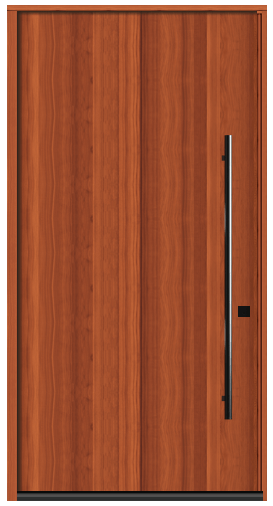
Flat
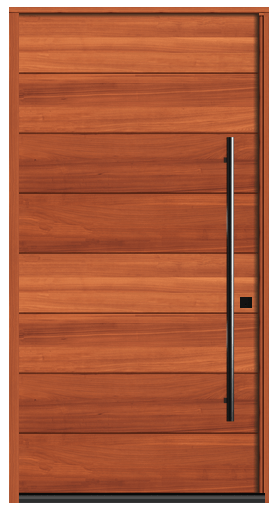
Solace
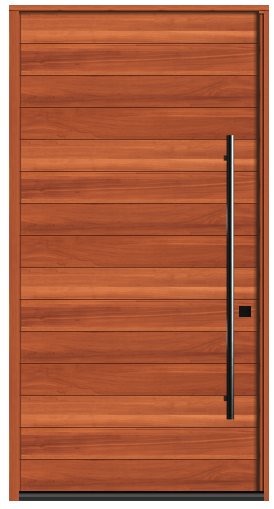
Dina
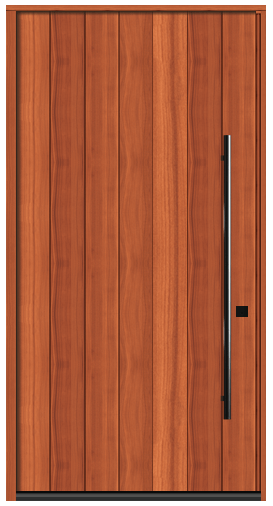
Pola
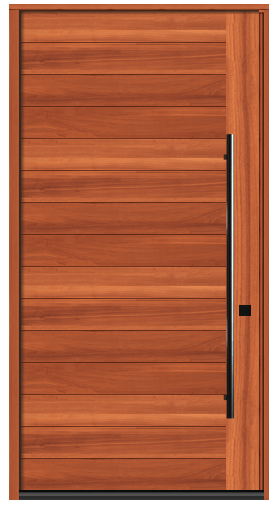
Finn
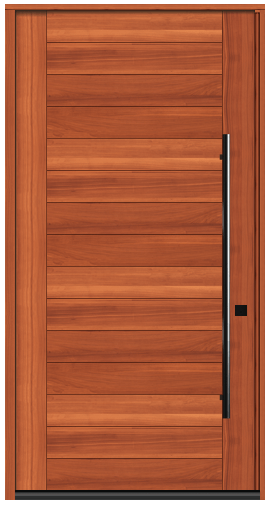
Urban
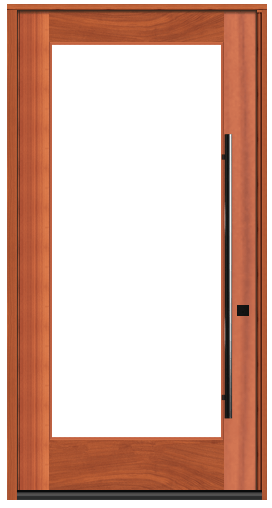
Glass
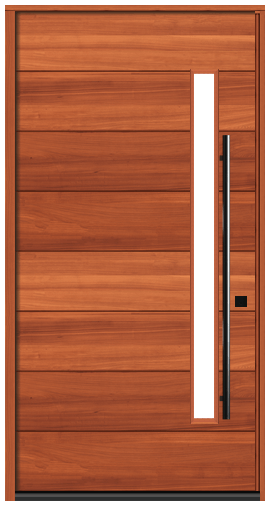
Line
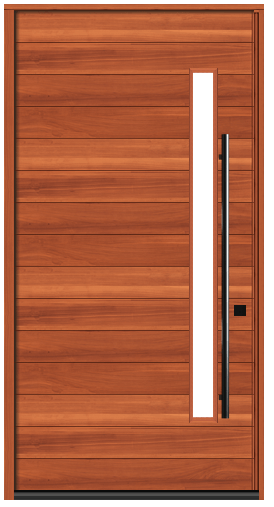
Katti
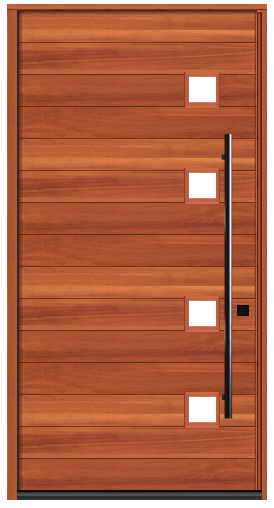
Eame
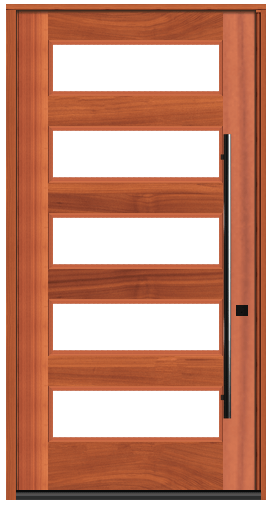
Sydney
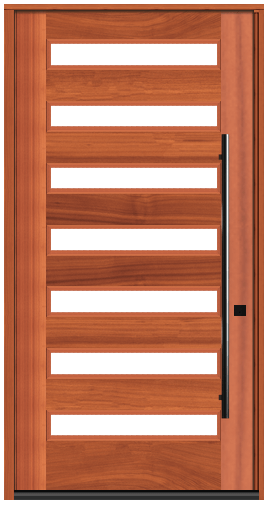
Hannah
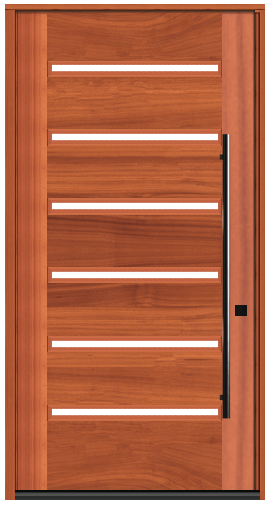
Lassen
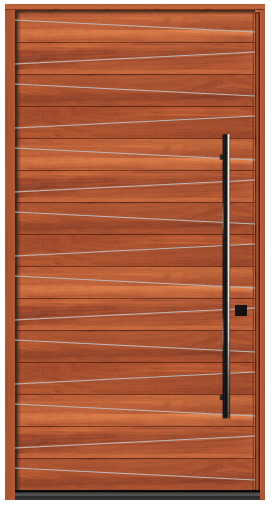
Robyn (6in)
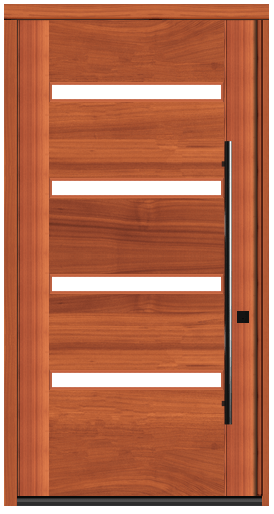
Ogden
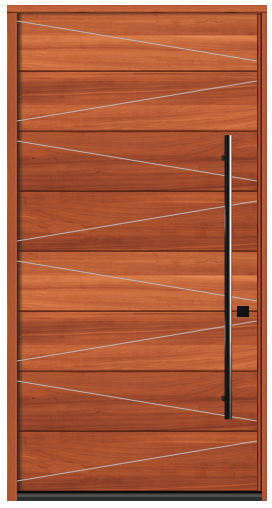
Robyn (12in)
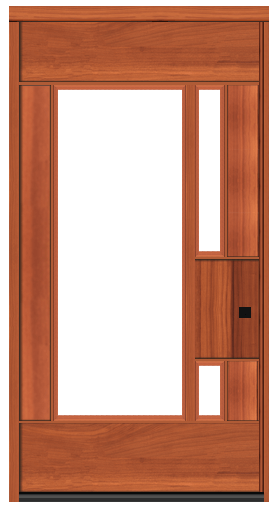
Kogan
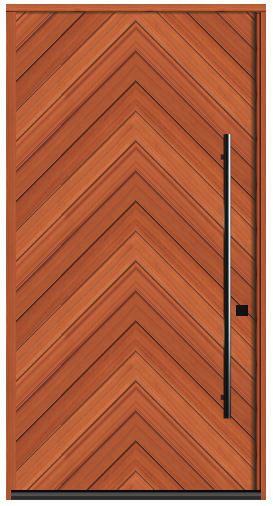
Lora
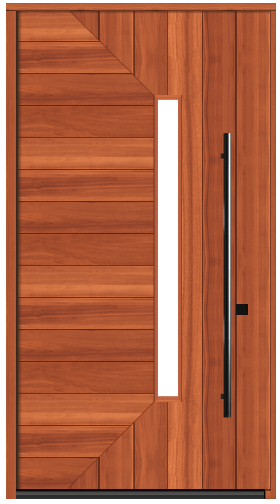
Lake
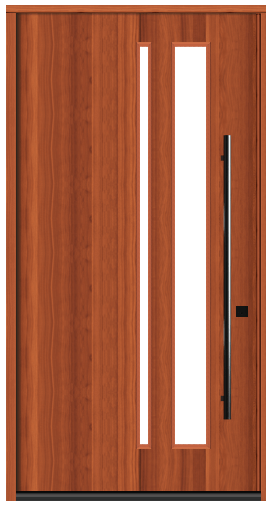
Park
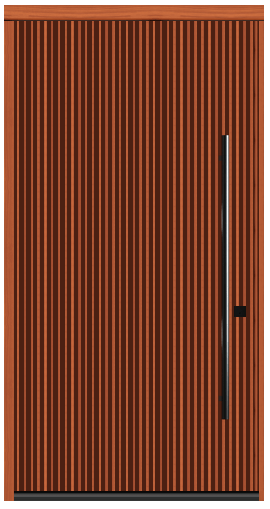
Dillon
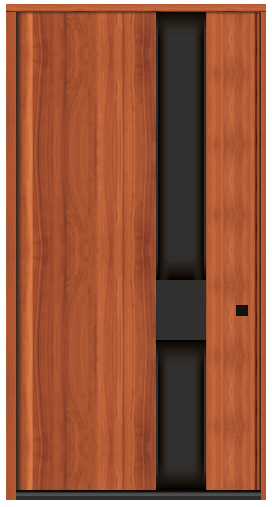
Mehta
Net Frame Size Wall System
Measurements to Know
When sizing the door you will need to consider two principle measurements,rough opening and frame size. See the image below for reference.

Rough Opening
The rough opening is the distance from stud to stud for framing purposes. We advise that you build a rough opening that is ½ in. wider and 1/2 in. taller than the total door unit. We find that this allows for sufficient shimming and adjustments during installation.
Frame Width
The Frame Width is the actual width of the door jamb. When determining the frame width you want to put in a number that is at least a half inch less than the rough opening size to allow room to square and level the door. For example, for a rough opening 48 inches wide, order a frame width of 47 1/2 inches.
Frame Height
The Frame Height is the actual height of the door jamb. This includes the the header and threshold. When determining the frame height you want to put in a number that is at least a half inch less than the rough opening size to allow room to square and level the door. For example, for a rough opening 96 inches tall, order a frame height of 96 1/2 inches.

Inlay Options
6″ Robyn Inlay Options
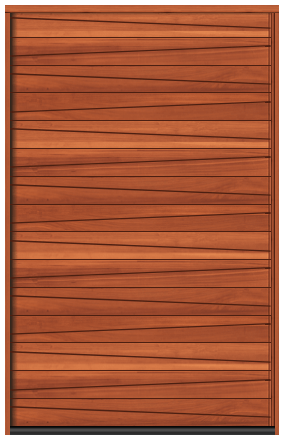
NO INLAYS
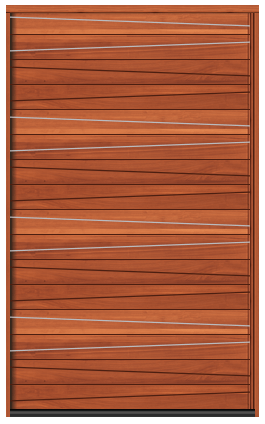
INLAY TWO THEN SKIP TWO
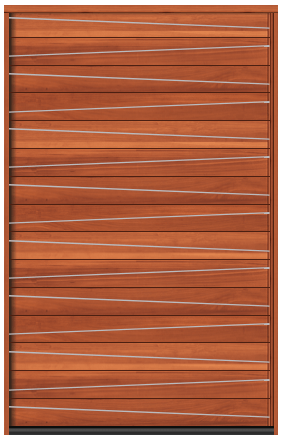
ALL
12″ Robyn Inlay Options
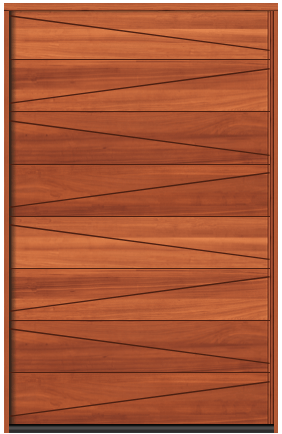
NO INLAYS
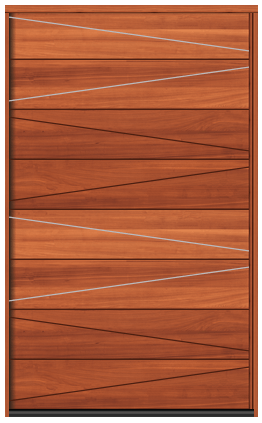
INLAY TWO THEN SKIP TWO
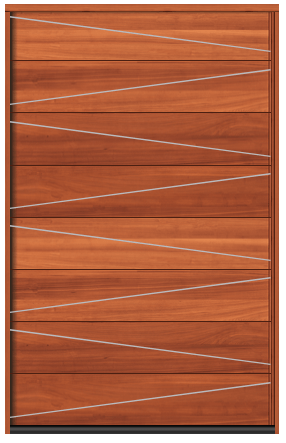
ALL
SideLights
GLASS SIDELIGHT PLACEMENT ON DOOR UNIT
You can choose between the following sidelight configurations: – Right Sidelight – Left Sidelight – Transom light – Double Sidelight – Left Sidelight with Transom – Right Sidelight with Transom – Double Sidelight with Transom.
Sidelight placement is specified with reference to the exterior view. If you want a 12″ sidelight that is on the right side when viewed from the exterior, click on the dropdown options under “Right Sidelight” and select the option: 12″ right sidelight. If you want a double sidelight, simply a size under both the the Right Sidelight and Left Sidelight options. Double sidelights can be of different sizes.
NET SIDELIGHT SIZE
This is the size of the actual Sidelight jamb. When inputting the net frame size you want to put in a number that is at least a half inch less than the rough opening size to allow room to square and level the unit. The door will be built with the sidelight attached so be sure to input the height of the door and the height of the sidelight the same.
Example: 48″ X 98″ door with a 18″ X 98″ sidelight will get you a door and sidelight combo that measures 66″ X 98″ (the rough opening size should be somewhere around 66 1/2″ X 98 1/2″).

Construction
The Kogan has Two Design Options:
Wood Option
– Core is packed with 1″ foam insulation for total R-value of 7
– Can be stained or painted
– Slightly different than the steel version (If painted black, most people cannot tell the difference)
– The wood option does not have the perimeter edge reveal
– Vertical wood divider between glass is about 1″ wider than the steel option
– 2 1/4″ thick overall
– Includes double steel-reinforced core wrapped with 1/4″ solid wood of your choice
– Can be stained or painted
– Slightly different than the steel version (If painted black, most people cannot tell the difference)
– The wood option does not have the perimeter edge reveal
– Vertical wood divider between glass is about 1″ wider than the steel option
– 2 1/4″ thick overall
– Includes double steel-reinforced core wrapped with 1/4″ solid wood of your choice
Steel Option
– The door is insulated but has no thermal breaks
– Powder Coated – standard is black, contact us if you would like to choose a different color
– 3″ thick overall
– Jamb will be made of your choice of wood
– Most customers choose a paint grade mahogany option to paint black to match the black powder coat
– Powder Coated – standard is black, contact us if you would like to choose a different color
– 3″ thick overall
– Jamb will be made of your choice of wood
– Most customers choose a paint grade mahogany option to paint black to match the black powder coat
Plank Height
The Robyn is available with either 12 inch tall planks or 6 inch tall planks with a diagonal reveal between planks.
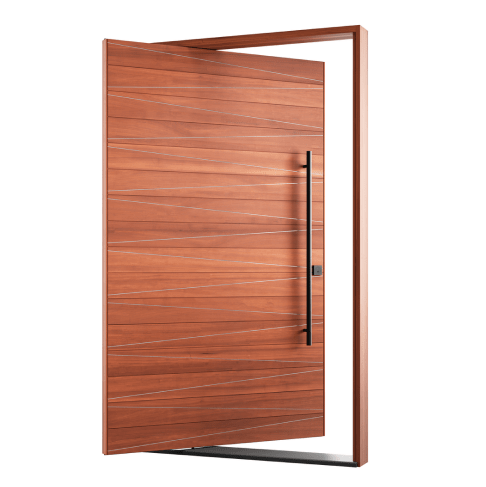
6″ Tall Planks
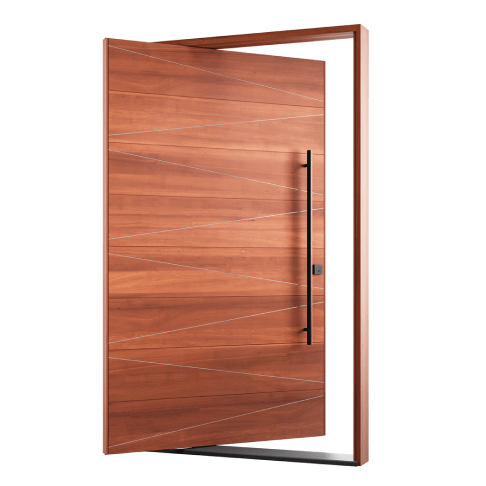
12″ Tall Planks
Mehta Handle Finish
Our standard color for the integrated handle is BLK-120 (black). You may choose any color available. We can purchase colors from the link below. Please look through the options, Prismatic Powders allows you to buy samples if you’d like to see the colors in person. We only need to know the color code.
Face Material Explanation
Please tell us a brief explanation of what face material you plan on applying.
Examples; unique lumber, siding, cold rolled steel, leather, reclaimed barn wood, drywall, tile, sugi ban, powder coated metal.
We can order many specialty woods, please contact us if the wood selection on our website does not have what you’re looking for. This product is for woods we’re unable to work with in our shop.
Face Thickness
The thickness of the face material you are applying will determine; the overall thickness of the door, how large the side caps should be and the jamb depth sizes available. Please contact us if the size you are doing is not listed.
Smart Deadbolt Type
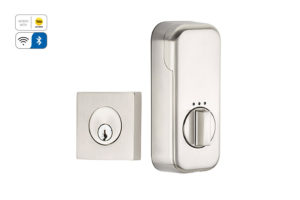
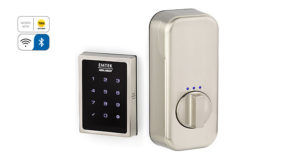
Making an account will allow you to save your orders, billing and shipping information. During the quoting process, PDFs of your quotes will be available in your account dashboard for you to download and show your clients. Your account will also save your past orders, allowing you to download past Invoices.
The need to make an account is more for companies and contractors than homeowners. If you have any questions at all, please feel free to contact us.
sales@pivotdoorcompany.com (719) 425-4289 Monday – Friday 8am – 4pm MT
Interior Prebuilt Wood Type
Choosing a Wood Species…
For pre-built Flat doors we offer four wood veneers: Mahogany (Sapele), Walnut, Paint Grade, White Oak. If you would like a greater range of wood types to choose from, you will need to order a customized exterior door. All our doors are shipped out unfinished and stain ready. (No stain or clear coat)
As you decide which wood you’ll choose, the most important factor is how the wood species goes with the overall design of the door and your project. If you have specific questions about what wood to choose that are not answered here, feel free to reach out to us.
Our Wood Selection for Pre-built

Mahogany (Sapele) Veneer
This exotic reddish-brown wood is desired for its rarity, strength, and beauty. It is very durable, and resists swelling and warping, making it ideal for marine uses and high moisture areas.
Walnut Veneer
Walnut is straight-grained in the trunk of the tree, but possesses a wavy grain in wood found closer to the roots. Walnut wood finishes beautifully, holding paint and stain exceptionally well.
White Oak Veneer
White Oak is valued for its light and even color.
Paint Grade
We offer a paint grade option made from Mahogany (Sapele) veneer. This is acceptable for painting using a variety of paint (pigment) products.
Inside Delivery
Pivot Door Company will hire a local third party moving company to move your crate from your FedEx local dock or accept delivery at your job site. The shipping contact will still need to be available to coordinate the delivery onsite. The moving company will then transport your crate inside your garage or house. Please note, the customer will be responsible for the conditions of the area it is stored. Our crates are not weatherproof. The shipping crate cannot be stored or transported on its side, only flat. While the moving company may take off the top crate lid for you to inspect the contents, they are not responsible for fully uncrating or removal of any trash.
Pivot Hardware
In almost all cases, customers will wish to specify the Free-swing A pivot hardware, which allows the door to move as a standard hinge hardware would. We offer a Free-swing B pivot hardware for applications that could benefit from pivot hardware with a lower profile. We offer the Closer hardware upgrade for customers using the door in commercial applications or for customers who want the doors to always return to a fixed position automatically. See descriptions and diagrams below.




Free-swing A and B Pivot Hardware
Our standard pivot hardware is a durable, specially engineered free-swing pivot. This pivot hardware works for a wide range of doors, from small to very large. Use the diagram below to determine if your application is better suited to Free-swing A or Free-swing B. No matter the door size, the free-swing pivot hinge allows for effortless door operation. The hardware incorporates sets of ball-bearings for smooth, long-lasting performance. The door swings freely around the pivot point. There are no springs or tension pulling the door closed.
Closer, Dorma BTS/80
In commercial applications and in rare residential applications, we install a bottom closer. The bottom closer creates constant tension on the door’s swing to pull the door into the closed position. This means one must hold the door in order to keep it open. With a closer the door will not rest in an open position unless the hold-open feature is activated, which holds the door open at a 100° angle.
Interior Pivot Hardware
Pivot Hardware
In almost all cases, customers will wish to specify the Standard Free-swing pivot hardware, which allows the door to move as a standard hinge hardware would. We offer the Closer hardware upgrade for customers using the door in commercial applications or for customers who want the doors to always return to a fixed position automatically.
Free-swing Pivot Hinge
Our standard pivot hardware is a durable, specially engineered free-swing pivot hinge. This pivot hardware works for a wide range of doors, from small to very large. No matter the door size, the free-swing pivot hinge allows for effortless door operation. The hardware incorporates sets of ball-bearings for smooth, long-lasting performance. The door swings freely around the pivot point. There are no springs or tension pulling the door closed.
Closer, Dorma BTS/80
In commercial applications and in rare residential applications, we install a bottom closer. The bottom closer creates constant tension on the door’s swing to pull the door into the closed position. This means one must hold the door in order to keep it open. With a closer the door will not rest in an open position unless the hold-open feature is activated, which holds the door open at a 100° angle.





Interior Swing Configuration
Swing configuration defines the direction of the door motion and from which side the pivot is placed. You can choose either a Right-hand Swing or a Left-hand Swing. The layout of your installation site will determine the swing configuration. To determine if the door is left-hand or right-hand swing, imagine you are looking at the door from the outside. If the pivot point is on the left side, it is a left-hand swing. If the pivot point is on the right-hand side, the door is a right-hand swing.
Use the diagram below to help identify which configuration will serve your project best.

Interior Pivot Placement
The pivot placement is the distance the pivot pin will be placed away from the vertical edge of the rough opening. Generally speaking, we suggest placing the pivot over one quarter of the distance of the door width. We find that this presents a solid aesthetic for most door dimensions.
If your rough opening is 48” and you choose a 9” pivot placement, the door will roughly have a 37” pass through opening. You want to ensure you leave at least a 36” opening. (Rough opening width – pivot placement measurement – 4 in. for jamb = a number greater than 36). See picture for details or contact us for clarification.

Suggested Pivot Placements
| Door Slab Width | Pivot Placement |
| 30″ – 34″ ……….. | 3″ |
| 35″ – 39″ ……….. | 4″ |
| 39″ – 41″ ……….. | 5″ |
| 42″ – 44″ ……….. | 6″ |
| 45″ – 48″ ……….. | 8″ |
Interior Frame Size
Measurements to Know
When sizing the door you will need to consider two principle measurements, rough opening and frame size. See the image below for reference.
Rough Opening
The rough opening is the distance from stud to stud for framing purposes. We advise that you build a rough opening that is ½ in. wider and 1/2 in. taller than the total door unit. We find that this allows for sufficient shimming and adjustments during installation.
Frame Width
The Frame Width is the actual width of the door jamb. When determining the frame width you want to put in a number that is at least a half inch less than the rough opening size to allow room to square and level the door. For example, for a rough opening 48 inches wide, order a frame width of 47 1/2 inches.
Frame Height
The Frame Height is the actual height of the door jamb. When determining the frame height you want to put in a number that is at least a half inch less than the rough opening size to allow room to square and level the door. For example, for a rough opening 96 inches tall, order a frame height of 96 1/2 inches.

Interior Prebuilt Frame Size
Net Frame Size
Use the information below when choosing a Frame Width and a Frame Height. We sell doors by frame size; the actual door size will be less than the frame size.
Available Widths and Heights
For pre-built doors, you may choose from the following frame widths and heights:
| FRAME
WIDTH |
FRAME
HEIGHT |
PIVOT
POSITION |
| 31 1/2″ | 81 3/4″ | 3″ |
| 37 1/2″ | 81 3/4″ | 3″ |
| 43 1/2″ | 81 3/4″ | 4″ |
| 49 1/2″ | 81 3/4″ | 6″ |
| 31 1/2″ | 97 3/4″ | 3″ |
| 37 1/2″ | 97 3/4″ | 3″ |
| 43 1/2″ | 97 3/4″ | 4″ |
| 49 1/2″ | 97 3/4″ | 6″ |
Measurements to Know
When sizing the door you will need to consider two principle measurements, rough opening and frame size. See the image below for reference.
Rough Opening
The rough opening is the distance from stud to stud for framing purposes. We advise that you build a rough opening that is ½ in. wider and 1/2 in. taller than the total door unit. We find that this allows for sufficient shimming and adjustments during installation.
Frame Width
The Frame Width is the actual width of the door jamb. When determining the frame width you want to put in a number that is at least a half inch less than the rough opening size to allow room to square and level the door. For example, for a rough opening 50 inches wide, order a frame width of 49 1/2 inches.
Frame Height
The Frame Height is the actual height of the door jamb. When determining the frame height you want to put in a number that is at least a half inch less than the rough opening size to allow room to square and level the door. For example, for a rough opening 97 1/2 inches tall, order a frame height of 97 inches.

Number of Doors
You must choose the number of doors that make up the wall system. We will use the Frame Width and the Number of Doors to calculate the width of the individual doors in the wall system. For example, if the frame width is 120 inches and you indicate that the Number of Doors in the wall system should be 5, the individuals doors will be approximately 24 inches wide. If the frame width is 120 inches and you indicate the Number of Doors should be 4, the individual doors will be approximately 30 inches wide. If the frame width is 120 inches and you indicate the Number of Doors should be 3, the individual doors will be approximately 40 inches wide. Please contact us directly if you wish to configure the wall system and door widths differently.












